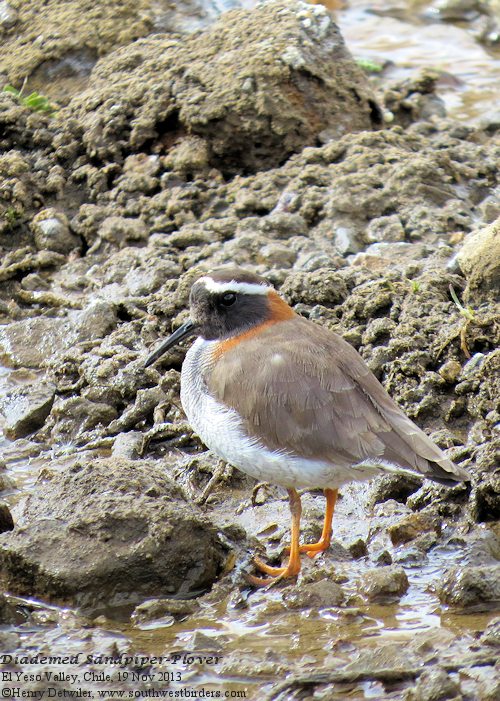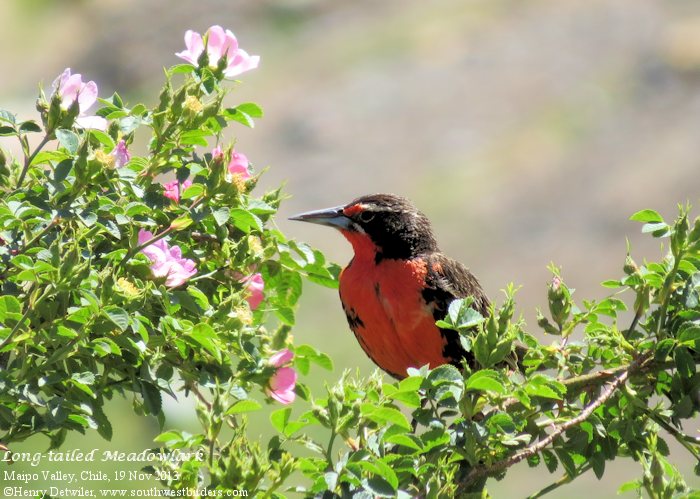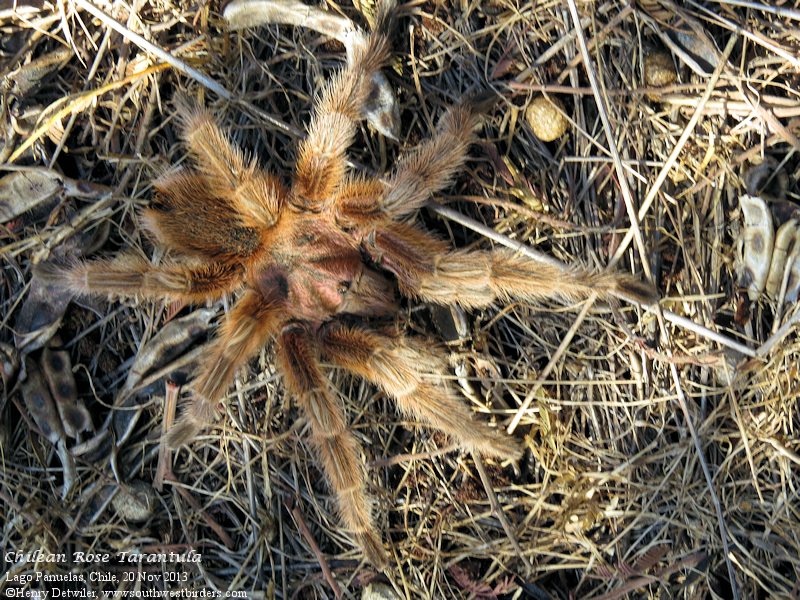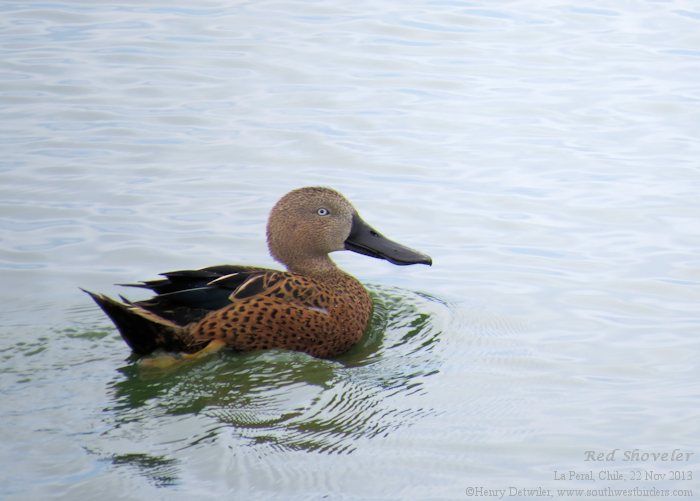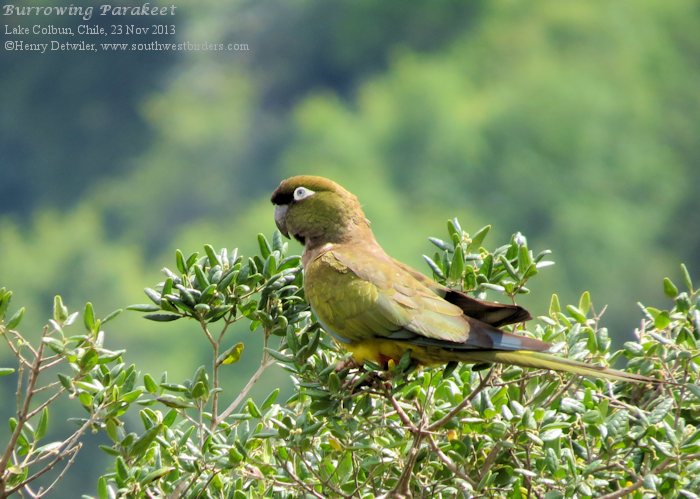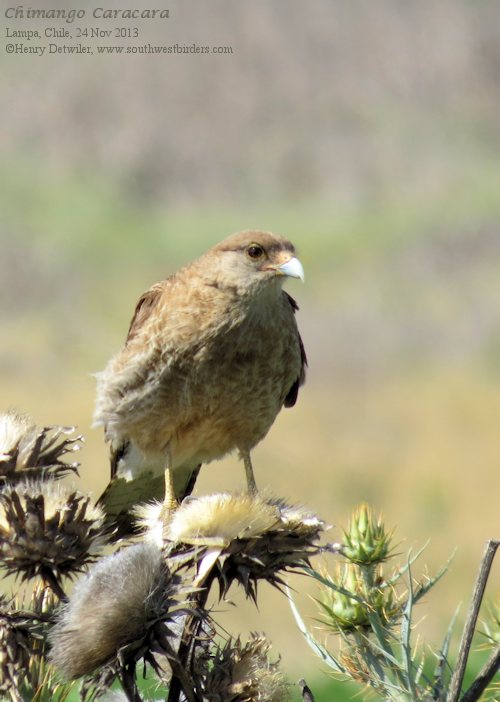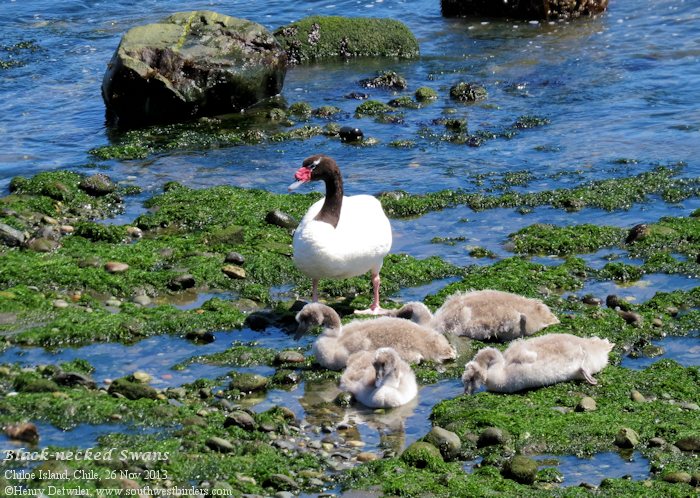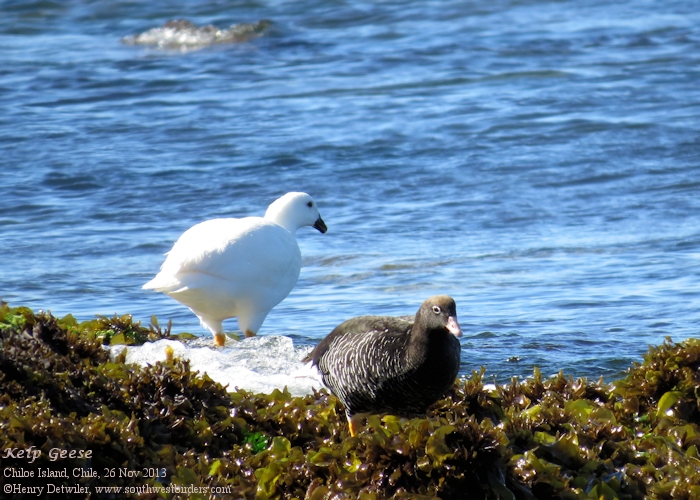Birding in Chile, 19-28 Nov 2013 Central Chile Suzanne and I had a wonderful time in Chile during November 2013, exploring the Andes and central coastline for six days, and then the Lake District and Chiloe Island for our final four days. We located 161 bird species, several mammals and reptiles, and enjoyed some incredible scenery. Logistics We flew into Santiago and rented a Suzuki 4x4 from Ace Rentals, serviced by Econorent. Make sure you bring along a copy of your internet reservation price—both in Santiago and Puerto Montt the Econorent providers tried to charge more than our confirmed rate. The extra clearance provided by the Suzuki was worth the additional money on the rutted and water-crossed gravel roads north of El Yeso, at Puyehue National Park, and on the way to the Chepu River in Chiloe. We made all but one of our lodging reservations through Booking.com. However, at two locations the staff did not know of our arrival—next time we’ll follow up with e-mails or phone calls directly to the lodging sites. At the very nice Hosteria de Vilches we reserved a cabin by sending them an e-mail through their web site. As do the Spanish and Argentinians, Chileans like to stay up late and sleep in late. If you go with a bed and breakfast option, you may not get your breakfast until after 10:00 a.m. One location, the Cabañas La Valenciana at Lake Puyehue, prepared a basket of breakfast items for us the night before! If you are staying at a lodge that is gated make arrangements ahead of time to be let out early. We spent half an hour trying to find someone to open the gate for us at the Hosteria de Vilches. We felt safe, most of the roads were in excellent shape, and we never went hungry. For breakfast and lunch we bought groceries at the mini mercardos or empenadas from roadside stands. For dinner we usually ate at our lodge or a nearby restaurant. We used a Garmin GPS with waypoints planned out and entered ahead of time. This saved us time and frustration in Santiago and other urban areas where the same street may have many names, and where there are a fair number of one-way streets. If you like to plot your routes ahead of time on Google Maps or Bing, we found the Bing maps to be more useful. Google favors more direct routes, but they are usually on smaller, slower roads that are often not at all well-signed. Most of the main highways we traveled on were toll roads. In and around Santiago the tolls are automated, and the fee is included with your rental vehicle. Outside the city you’ll be paying at toll stations on a regular basis (anywhere from about $1.00 - $4.40 U.S.). Itinerary A waterfall spills over the road close to km 6; just around the corner from this site is a small pasture abutting a rocky cliff and hillside. The meadow was home to SOUTHERN LAPWING, more BLACK-WINGED GROUND DOVES, and a couple of LONG-TAILED MEADOWLARKS. On this hillside we found our only endemic CRAG CHILIAS, as well as the endemic MOUSTACHED TURCA, TUFTED TIT-TYRANT, and WHITE-SIDED HILLSTAR. As we were about to move on, Suzanne spotted some tiny specs floating above the opposite ridge line—our first ANDEAN CONDORS! The road leading up the valley to the dam was in good shape and not too crowded, but the next day we hit the early-morning construction traffic (buses, pick-ups, and trucks) heading up to work on a piping project at the outflow from the dam. With lots of traffic, the dust can be blinding. Once the road starts to traverse the reservoir it narrows dramatically—basically one lane for the next few kilometers (with occasional pullouts), with a steep drop into the water on one side and a loose rocky, cliff on the other. This wouldn’t have been too bad except for the heavy-duty gravel trucks rumbling over the road in both directions. Since the trucks were in radio contact with one another, we hung behind one at a pullout, and then followed him for the duration. Once at the far (northeast) side of the lake, both the road and the birding improved dramatically! We started seeing our first GROUND-TYRANTS and SCALY-THROATED EARTHCREEPERS, and just prior to the wooden bridge Suzanne spotted the first of many GRAY-BREASTED SEEDSNIPES. Right after the bridge we turned off onto the traditional track to the DIADEMED SANDPIPER-PLOVER (DSP) bog. But high water discouraged any chance of a vehicle crossing, and we didn’t favor wading the icy glacial melt. GREY-HOODED SIERRA-FINCHES were common, and we also spied a small flock of YELLOW-RUMPED SISKINS. Another five kilometers down the road we passed by another bog, and walking along the edge I flushed a MAGELLANIC TAPACULO. In another few kilometers the road split, with the left fork going to the quarry (thank goodness!), and the right fork into the Parque Valle del Yeso, proclaimed by a large sign and a small guard shack. The road was wet from water dripping down the hillside, forming a nice bog on both sides of the road. A short while farther we stepped out to explore the pools and look for our target bird. A couple of really large mammals bounded away as we walked around the area; they might have been vizsachas. Farther along still (perhaps 6 km from the entrance to the park) we parked on a bluff overlooking a large rocky plain with numerous feeder streams going into the El Yeso River. In the distance a group of birders was parked and exploring the bog, no doubt also seeking the DSP. Suzanne spotted a group of geese feeding on a grassy plain in the distance, and looks with the scope revealed a dozen UPLAND GEESE and 8 CRESTED DUCKS. As we walked the edge of the bluff we flushed a GREY-BREASTED SEEDSNIPE sitting on 4 black-spotted eggs. Down on the river, an out-of-place SPECKLED TEAL flew in, drawing our eyes to a DARK-BELLIED CINCLODES. A bit more scoping down close to the birders along the river revealed two SANDPIPER-PLOVERS that they were watching! A distant view, to be sure, but still a positive ID. We would have liked to travel farther along our birdy road, but it was already past 5:00 p.m., so we started our return journey. As we drove through the bog close to the Parque Valle del Yeso entrance, we had one more surprise in store for us—a small bird on the side of the muddy track—a handsome male DSP! We jumped out of the SUV and got wonderful views and photos. We spent the night in a lodge in San Alfonso, a few kilometers up the road from San Jose del Maipo, a larger town with a gas station, two larger grocery stores, and restaurants. Wed (20 Nov 2013) We then drove up the Maipo Canyon to Baños Morales. In a pasture with grazing horses we spotted a fancy rufous and black male AUSTRAL NEGRITO, and then its tan-colored mate. At the bridge over the Maipo River leading to Baños Morales we scanned the river and located a male TORRENT DUCK (thanks to prior trip reports!). In the weedy hillside we added PLUMBEOUS SIERRA-FINCH. After lunch we made our way to the coast, stopping briefly at Laguna Peñuelas for our first introduction to Chile’s many lowland water-loving birds. Approximately 86 kilometers west of the Santiago ring road, we exited Highway 68, paid our fee at the entrance kiosk, and drove down to the lake. PERUVIAN PELICANS, COSCORABA SWANS, YELLOW-BILLED PINTAILS, CHILOE WIGEONS, a variety of COOTS, and COCOI HERONS were plentiful. CHIMANGO CARACARAS, SOUTHERN LAPWINGS, and CORENDERA PIPIS were also everywhere. As we were driving on one of the sandy tracks I spotted a big spider crossing in front of us. We jumped out of the SUV and got wonderful looks at our first Chilean Rose Tarantula. Another hour skirting the coast took us just north of Concón to our lodge for the next two nights, the beautifully situated Posada del Parque. This attractive place is perched on a bluff overlooking a small estuary teaming with coots, rails, ducks, and other birdlife. A walk after dinner turned up many new birds for us, including RED SHOVELER, MANY-COLORED RUSH-TYRANT, and LITTLE BLUE HERON. The enthusiastic owner, Oswaldo, told us of his restoration efforts and how proud he was of the many returning birds. A BARN OWL was screeching in a nest hole in one of his palms off the patio. Thu (21 Nov 2013) After a tasty lunch of empenadas, we headed north and east to our next destination, a small rocky islet offshore from Cachagua. We parked on the bluff overlooking the island and took several flights of stairs down to the beach. Later we discovered we could have driven down to the beach south of the island, and avoided the extra flights down and up! Looking across the channel to the rocky and cactus-studded slopes of the island we surveyed HUMBOLDT PENGUINS, KELP GULLS, PERUVIAN PELICANS and BOOBIES, BLACKISH OYSTERCATCHERS, and two trees full of NEOTROPIC CORMORANTS. Walking north along the rocky coast we soon found the endemic SEASIDE CINCLODES and a single marine otter feeding in the surf. A PEREGRINE FALCON swooped overhead and landed on a tree with what appeared to be a small dove. On the way back south we stopped at the ponds in the Las Salinas industrial area, and added a couple more waterfowl and gulls: LAKE DUCK and FRANKLIN’S GULLS. Access the Aconcagua River Estuary turned out to be an easy matter—there is a nature park immediately north of the first bridge over the river (just past the city of Concón). Here we watched hundreds of FRANKLIN’S GULLS, BLACK SKIMMERS, WHITE-BACKED STILTS, AMERICAN OYSTERCATCHER, and WHIMBRELS. Fri (22 Nov 2013) Next was the small nature preserve around Laguna Peral. SILVERY-CHEEKED GREBE, PLUMBEOUS RAIL, GRASS WREN, WREN-LIKE RUSHBIRD, and an assortment of gulls and waterfowl greeted us. We surveyed the lake from several spots hoping for a bittern, but no luck. In the surrounding shrubbery we got great looks at TUFTED TIT-TYRANT, GRASSLAND YELLOW-FINCH, and a single PLAIN-MANTLED TIT-SPINETAIL. Down the road a little farther was Laguna Cartagena. Unfortunately the gate and visitor center were closed, but we were able to see many of the birds here by looking through the fence at the north end. New for us were BLACK-NECKED SWAN, SPOT-FLANKED GALLINULE, and WHITE-TUFTED GREBE. In the estuary north of the lake were SOUTH AMERICAN and ELEGANT TERNS, BAIRD’S SANDPIPERS, and many gulls. From here we took a several-hour drive cross-country to San Fernando, and then another 23 km east to the Shangri La Lodge. Our reservation had been lost, but the proprietors found us a fine spot among their many rooms. In the near-by river was a family of TORRENT DUCKS and the ever-present DARK-BELLIED CINCLODES. The owner alerted us to the presence of GREAT HORNED OWLS next to our room and sure enough we heard them throughout the night. On our way to dinner we also had a fly-over of 30-40 BURROWING PARROTS! Dinner was tasty empenadas, sliced apples, and red wine. Sat (23 Nov 2013) A couple of hours down the Pan-American Highway we turned east in the city of Talca and drove another hour to reach Lago Colbún. Just beyond the far end of the lake, we stopped in several locations which afforded us views of the river. At each of those spots we heard and saw BURROWING PARROTS, getting nice views of both flying and perched birds. The parrots were especially beautiful on the wing—wish my compact superzoom were fast enough to capture flying birds—maybe in a couple more years. We drove up to Vilches and checked into the very nice Hosteria de Vilches. Then we drove up to Altas de Lircay National Park. It was their (late) lunch hour, so the visitor center was closed, and we couldn’t get a key to drive up the main road into the park. We took a short hike up a side trail and returned an hour later. Then we found a lady ranger who unlocked the gate, and we drove up to the administrative offices, paid our entrance fee, and got instructions to the Aliwenmawida trail. It was a beautiful walk, winding through the primeval forest, along streams, and through dense bamboo stands. Suzanne heard some scratching at one spot and we got glimpses of CHESTNUT-THROATED TAPACULO. Not far past the lookout, I head a double knock, and we quickly headed up the trail towards the sound. Then the bird flew and we saw a big male MAGELLANIC WOODPECKER. It didn’t go too far, and we soon had the creature in our binocular sights—a fine Pileated-woodpecker-sized bird with jet black back and flaming red crest. This trail also produced our first TREERUNNERS, trilling from the very tops of the trees. As we walked back to our SUV I did a pygmy-owl imitation and called in a number of birds, including a lovely GREEN-BACKED FIRECROWN. We had a wonderful dinner prepared by Claudio and excellent pisco sours, after which we drove back out to the park to listen for owls. Alas, a large group of college students was partying in the campground, their boom box music carrying far into the forest, obliterating any natural nocturnal sounds. We gave up after a short hike and retired for the night. Sun (24 Nov 2013) Mon (25 Nov 2013) After lunch at Entre Lagos (also called Puyehue) we drove up the road into Puyehue National Park. It wasn’t long before we heard our first BLACK-THROATED HUET-HUETS, and even spotted one scurrying up slope. At a stream we very happy to lure a PATAGONIAN TYRANT into view. On one short trail to an overlook we heard AUSTRAL PARAKEETS, and on another trail we saw a small flock of them. At the ski lodge near the top of the mountain we found the way to the Raihuen Crater blocked by a gate. A couple of the maintenance workers told us we could lift the gate and proceed on up, and that the road conditions were just fine. So we drove on up the mountain over a good black volcanic gravel track. The views were great as we ascended above the tree line, and it wasn’t long before we reached the crater. At first all was quiet, but when we hiked into the pit we started hearing a few sparrow-like chips. A bit of playback and our primary targets appeared—a pair of YELLOW-BRIDLED FINCHES. As I was taking photos Suzanne spotted a BUFF-WINGED CINCLODES. A fine iridescent-spotted lizard was one of the few reptiles we spotted. We closed out the day with a fine salmon dinner and more Castillero del Diablo at the Cabañas La Valenciana Restaurant. Tue (26 Nov 2013) At the Darwin Biological Center we hiked one of the stream side trails and heard both BLACK-THROATED HUET-HUET, and CHUCAO and OCHRE-FLANKED TAPACULOS. But the star of this outing was a fancy DES MURS’ WIRETAIL with its four long, graceful, tail streamers swishing in the breeze. We stopped in Ancud to check in at our lodge, the Cabañas Arena Gruesa, and then we hit the road again for Punihuil, site of the only mixed MAGELLANIC and HUMBOLDT PENGUIN mixed colony. The MAGELLANICS were easy to find from shore, as were the numerous DARK-BELLIED CINCLODES and KELP GULLS, and a single pair of KELP GEESE. Just before we were about to depart the site these geese flew into the rocks close by us, affording us the opportunity to admire the beautifully patterned female. With plenty of daylight left, we decided to head for Fort Anhui on, a large Spanish coastal defense battery on one of the northern points of the island. On the way we skirted some coastal ponds which held our only CINNAMON TEAL of the trip. At the fort we had a great view over the channel, and were able to spot a PARASITIC JAEGER among a large flock of terns. During the hike up and back from the fort we heard the ringing calls of several more BLACK-THROATED HUET-HUETS and OCHRE-FLANKED TAPACULOS. That night we enjoyed a local dish of Coranto, which consisted of clams, mussels, potato dumpling, and sausage baked in a pit in the ground, plus a couple more pisco sours. The cabin we stayed at was somewhat run-down with a lumpy bed, and the only heat was from a wood-fired stove. It provided great heat while I was up to stoke the fire, but that died out soon after we retired to bed. Wed (27 Nov 2013) From here we drove south to Castro, the large, boisterous capital of Chiloe. After procuring and scanning a local map we made our way to the Pacific coastline. It was a scenic drive, but with a few too many potholes lying in wait. Some very pretty lagoons graced the coastline and in the ocean itself we watched as local fishermen cast big nets into the surf. On the way back to the lodge we came upon more over flights of SLENDER-BILLED PARAKEETS, and in one place we stopped in time to see a pair of them perched in a large eucalyptus tree. Thu (28 Nov 2013) From Puerto Montt we hugged the coastline in search of other species, and about 12 km east of the city we arrived at some huge mudflats which appeared to have some pinkish dots in the distance. The scope revealed a flock of far-away CHILEAN FLAMINGOS. We started hiking in their direction, but we hadn’t taken more than a few steps when they took to the wing and flew off over the dunes. They were our last new birds of the trip, and most magnificent ones, at that! We flew back to Santiago, spent one final night at the airport Holiday Inn, and headed home on Friday morning. |
